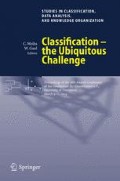Abstract
This paper analyses the influence of 13 stylized facts of the German economy on the West German business cycles from 1955 to 1994. The method used in this investigation is Statistical Experimental Design with orthogonal factors. We are looking for all existing Plackett-Burman designs realizable by coded observations of these data. The plans are then analysed by regression with forward selection and various classification methods to extract the relevant variables for separating upswing and downswing of the cycles. The results are compared with already existing studies on this topic.
This work has been supported by the Deutsche Forschungsgemeinschaft, Sonder-forschungsbereich 475. We also thank Uwe Ligges and Karsten Luebke for their support.
Access this chapter
Tax calculation will be finalised at checkout
Purchases are for personal use only
Preview
Unable to display preview. Download preview PDF.
References
HEDAYAT, A., SLOANE, N. and STUFKEN, J. (1999): Orthogonal Arrays. Springer Verlag, New York, Berlin, Heidelberg.
HEILEMANN, U. and MÜNCH, J. (1999): Classification of West German Business Cycles. Technical Report 11, SFB 475 Universität Dortmund.
PLACKETT, R. L. and BURMAN, J. P. (1946): The design of optimum multifactorial experiments. Biometrica, 33, 305–325.
RÖVER, C. (2003): Musikinstrumentenerkennung mit Hilfe der Hough-Transformation. Diplomarbeit, Fachbereich Statistik, Universität Dortmund.
WEIHS, C. and JESSENBERGER, J. (1999): Statistische Methoden zur Qualitätssicherung und-optimierung in der Industrie. Wiley-Vch, Weinheim.
WEIHS, C., RÖHL, M.C. and THEIS, W. (1999): Multivariate Classification of Business Phases. Technical Report 26, SFB 475, Universität Dortmund.
WEIHS, C. and GARCZAREK, U. (2002): Stability of multivariate representation of business cycles over time. Technical Report 20, SFB 475, Universität Dortmund.
Author information
Authors and Affiliations
Editor information
Editors and Affiliations
Rights and permissions
Copyright information
© 2005 Springer-Verlag Berlin · Heidelberg
About this paper
Cite this paper
Pumplün, C., Weihs, C., Preusser, A. (2005). Experimental Design for Variable Selection in Data Bases. In: Weihs, C., Gaul, W. (eds) Classification — the Ubiquitous Challenge. Studies in Classification, Data Analysis, and Knowledge Organization. Springer, Berlin, Heidelberg. https://doi.org/10.1007/3-540-28084-7_20
Download citation
DOI: https://doi.org/10.1007/3-540-28084-7_20
Publisher Name: Springer, Berlin, Heidelberg
Print ISBN: 978-3-540-25677-9
Online ISBN: 978-3-540-28084-2
eBook Packages: Mathematics and StatisticsMathematics and Statistics (R0)

